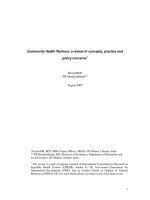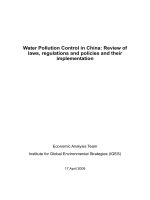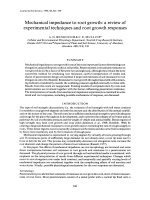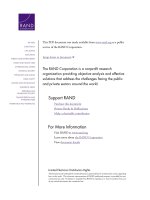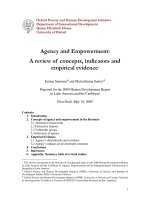ANL DIS 13 05 review of existing hydro and PSH models
Bạn đang xem bản rút gọn của tài liệu. Xem và tải ngay bản đầy đủ của tài liệu tại đây (1.7 MB, 102 trang )
Review of Existing Hydroelectric
Turbine-Governor Simulation Models
ANL/DIS-13/05
Decision and Information Sciences
Availability of This Report
This report is available, at no cost, at It is also available
on paper to the U.S. Department of Energy and its contractors, for a processing fee, from:
U.S. Department of Energy
OfceofScienticandTechnicalInformation
P.O. Box 62
Oak Ridge, TN 37831-0062
phone (865) 576-8401
fax (865) 576-5728
Disclaimer
This report was prepared as an account of work sponsored by an agency of the United States Government. Neither the United States
Governmentnoranyagencythereof,norUChicagoArgonne,LLC,noranyoftheiremployeesorofcers,makesanywarranty,express
or implied, or assumes any legal liability or responsibility for the accuracy, completeness, or usefulness of any information, apparatus,
product,orprocessdisclosed,orrepresentsthatitsusewouldnotinfringeprivatelyownedrights.Referencehereintoanyspecic
commercial product, process, or service by trade name, trademark, manufacturer, or otherwise, does not necessarily constitute or imply
its endorsement, recommendation, or favoring by the United States Government or any agency thereof. The views and opinions of
documentauthorsexpressedhereindonotnecessarilystateorreectthoseoftheUnitedStatesGovernmentoranyagencythereof,
Argonne National Laboratory, or UChicago Argonne, LLC.
This report is being disseminated by the Department of Energy. As such, this document was prepared in compliance with Section 515 of
the Treasury and General Government Appropriations Act for Fiscal Year 2001 (Public Law 106-554) and Information Quality Guidelines
issuedbytheDepartmentofEnergy.Althoughthisreportdoesnotconstitute“inuential”information,asthattermisdenedinDOE’s
InformationQualityGuidelinesortheOfceofManagementandBudget’sInformationQualityBulletinforPeerReview,thestudywas
reviewedbothinternallyandexternallypriortopublication.Forpurposesofexternalreview,thestudybenetedfromtheadviceand
comments of an advisory working group consisting of more than 30 experts from the industry, government, and research institutions.
About Argonne National Laboratory
Argonne is a U.S. Department of Energy laboratory managed by UChicago Argonne, LLC
undercontractDE-AC02-06CH11357.TheLaboratory’smainfacilityisoutsideChicago,
at 9700 South Cass Avenue, Argonne, Illinois 60439. For information about Argonne
and its pioneering science and technology programs, see www.anl.gov.
Review of Existing Hydroelectric
Turbine-Governor Simulation Models
ANL/DIS-13/05
prepared for
U.S.DepartmentofEnergy–WindandWaterPowerTechnologiesOfce
prepared by
Vladimir Koritarov and Leah Guzowski
Decision and Information Sciences, Argonne National Laboratory
JamesFeltes,YuriyKazachkov,BaldwinLam,CarlosGrande-Moran,
Gary Thomann and Larry Eng
Siemens PTI
Bruno Trouille and Peter Donalek
MWHAmericas
August 2013
This page intentionally left blank.
Preface
This report is one of several reports developed during the U.S. Department of Energy
(DOE) study on the Modeling and Analysis of Value of Advanced Pumped Storage
Hydropower in the United States. The study was led by Argonne National Laboratory in
collaboration with Siemens PTI, Energy Exemplar, MWH Americas, and the National
Renewable Energy Laboratory. Funding for the study was provided by DOE’s Office of
Energy Efficiency and Renewable Energy (EERE) through a program managed by the
EERE’s Wind and Water Power Technologies Office (WWPTO).
The scope of work for the study has two main components: (1) development of vendor-
neutral dynamic simulation models for advanced pumped storage hydro (PSH)
technologies, and (2) production cost and revenue analyses to assess the value of PSH
in the power system. Throughout the study, the project team was supported and guided
by an Advisory Working Group (AWG) consisting of more than 30 experts from a diverse
group of organizations including the hydropower industry and equipment manufacturers,
electric power utilities and regional electricity market operators, hydro engineering and
consulting companies, national laboratories, universities and research institutions,
hydropower industry associations, and government and regulatory agencies.
The development of vendor-neutral models was carried out by the Advanced
Technology Modeling Task Force Group (TFG) and was led by experts from Siemens
PTI with the participation of experts from other project team members. First, the
Advanced Technology Modeling TFG reviewed and prepared a summary of the existing
dynamic models of hydro and PSH plants that are currently in use in the United States.
This is published in the report Review of Existing Hydroelectric Turbine-Governor
Simulation Models. The review served to determine the needs for improvements of
existing models and for the development of new ones.
While it was found that the existing dynamic models for conventional hydro and PSH
plants allow for accurate representation and modeling of these technologies, it was
concluded that there is a need for the development of dynamic models for two PSH
technologies for which there were no existing models available in the United States at
the time of the study. Those two technologies are (1) adjustable speed PSH plants
employing doubly-fed induction machines (DFIM), and (2) ternary PSH units. The
Advanced Technology Modeling TFG developed vendor-neutral models of these two
PSH technologies, which are published in two reports: (1) Modeling Adjustable Speed
Pumped Storage Hydro Units Employing Doubly-Fed Induction Machines, and (2)
Modeling Ternary Pumped Storage Units.
Extensive testing of newly developed models was performed using the Siemens PTI’s
standard test cases for the Power System Simulator for Engineering (PSS
®
E) model as
well as the Western Electricity Coordinating Council’s (WECC’s) modeling cases for
Western Interconnection that were provided in PSS
®
E format. The results of model
iii
testing are presented in the report Testing Dynamic Simulation Models for Different
Types of Advanced Pumped Storage Hydro Units.
In addition to review by the project team members and the DOE, all these reports have
been reviewed by members of the AWG, and their comments and suggestions have
been incorporated into the final versions of the reports. Parts of these reports will also be
included in the final report for the entire study to illustrate the model development
component of the work.
iv
Acknowledgements
The authors would like to acknowledge the support and guidance provided to the project
team by the staff and contractors of the DOE/EERE’s Wind and Water Power
Technologies Office (WWPTO), including Michael Reed, Rajesh Dham, Charlton Clark,
Rob Hovsapian, Patrick O’Connor, Richard Gilker, and others. The authors are also
grateful to the members of the Advisory Working Group for their excellent collaboration
and efforts in advising the project team and guiding the study. The Advisory Working
Group included a broad spectrum of global pumped storage hydropower specialists
including:
Rajesh Dham, Charlton Clark, Rob
Hovsapian, Patrick O'Connor,
Richard Gilker
DOE/EERE – Wind and Water Power Technologies
Office (WWPTO)
Rachna Handa
DOE – Office of Electricity Delivery and Energy
Reliability (OE)
Rahim Amerkhail
Federal Energy Regulatory Commission (FERC)
Michael Manwaring, Douglas Divine
National Hydropower Association (NHA)
Mark Jones, Elliot Mainzer
Bonneville Power Administration (BPA)
Xiaobo Wang
California Independent System Operator (CAISO)
Zheng Zhou
Midwest Independent System Operator (MISO)
Matt Hunsaker
Western Electricity Coordinating Council (WECC)
Tuan Bui
California Department of Water Resources (CDWR)
David Harpman
Bureau of Reclamation (Reclamation)
Kyle L. Jones
U.S. Army Corps of Engineers (USACE)
Scott Flake, Greg Brownell
Sacramento Municipal Utility District (SMUD)
Paul Jacobson, Stan Rosinski
Electric Power Research Institute (EPRI)
Alan Soneda
Pacific Gas and Electric Co. (PG&E)
Osamu Nagura
Hitachi Mitsubishi Hydro
Teruyuki Ishizuki
Toshiba Corp.
Rick Miller. Rick Jones
HDR Engineering Inc. (HDR|DTA)
Jiri Koutnik, Maximilian Manderla
Voith Hydro
Christophe Nicolet
Power Vision Engineering (PVE)
Peter McLaren
Center for Advanced Power System (CAPS)
Landis Kannberg
Pacific Northwest National Laboratory (PNNL)
Klaus Engels
E.ON Wasserkraft GmbH
Kim Johnson
Riverbank Power
Steve Aubert, Le Tang
ABB Switzerland Ltd.
Ali Nourai
DNV KEMA
v
This page intentionally left blank.
vi
Contents
Preface i
Acknowledgements iii
Section 1 Introduction 1-1
Section 2 Power System Dynamic Overview 2-1
2.1 Interaction between Main Elements of Power Systems and their
Controls 2-1
2.1.1 Generators 2-3
2.1.2 Excitation Systems 2-6
2.1.3 Governor and Prime Mover Controls 2-8
2.2 Hydroelectric Generating Plants 2-9
Section 3 Hydro Turbine-Governor 3-1
3.1 Modeling Approach 3-1
3.2 Simulation Models in PSS
E 3-5
3.2.1 HYGOV Model 3-5
3.2.2 HYGOV2 Model 3-7
3.2.3 HYGOVM Model 3-8
3.2.4 HYGOVT Model 3-13
3.2.5 IEEEG2 Model 3-16
3.2.6 IEEEG3 Model 3-17
3.2.7 PIDGOV Model 3-18
3.2.8 TURCZT Model 3-20
3.2.9 TWDM1T Model 3-21
3.2.10 TWDM2T Model 3-23
3.2.11 WEHGOV Model 3-25
3.2.12 WPIDHY Model 3-27
3.2.13 WSHYDD Model 3-28
3.2.14 WSHYPG Model 3-30
3.3 An Example of the Prevalence of the Hydro Models in a Large U.S.
Simulation Database Using the PSS
E Software 3-32
Section 4 PSLF Hydro Turbine-Governor Simulation Models 4-1
vii
4.1 Simulation Models in PSLF Version 18 4-1
4.1.1 GPWSCC Model 4-1
4.1.2 G2WSCC Model 4-4
4.1.3 HYG3 Model 4-6
4.1.4 HYGOV Model 4-8
4.1.5 HYGOV4 Model 4-10
4.1.6 HYGOVR Model 4-12
4.1.7 IEEEG3 Model 4-14
4.1.8 PIDGOV Model 4-16
4.1.9 HYPID Model 4-18
4.1.10 HYST1 Model 4-20
4.1.11 W2301 Model 4-22
4.1.12 HYGOV8 Model 4-24
4.2 An Example of the Prevalence of the Hydro Models in a WECC
Region Database Using the PSLF Software 4-29
Section 5 Modeling of Conventional Pumped Storage Hydro Plants 5-1
Section 6 Bibliography 6-Error! Bookmark not defined.
viii
Introduction
Section
1
Introduction
This report is the first in a series of documents to be issued in the course of a DOE project
titled “Modeling and Analysis of Value of Advanced Pumped Storage Hydropower in the U.S.”
We are all intimately familiar with small energy storage devices; we use batteries of various
types in our cell phones and other electronic devices as well as the more traditional battery-
powered devices such as flashlights and radios. However, storing large amounts of energy,
on the scale that would be useful for a utility-scale power system, has been a much more
challenging task. While several new technologies are being developed, pumped storage
hydro is the most widely employed method available for storing large amounts of energy to
supply electricity. The basic concept of pumped storage is quite simple: electricity is used to
pump water up to an elevated reservoir, where the energy can be stored as potential energy
until it is needed; then electricity is generated by letting the water flow back down thorough a
turbine/generator. Of course, since there is a loss of energy due to the pumping and
generating cycle (as low as 10% for some new plants), there must be an economic incentive
for the storage, such as a variation in electricity prices between times of pumping and
generating.
Energy usage is greatly influenced by the normal schedule of people (high during the day
when people are most active and low at night) and weather (high when the temperature is
very hot or cold and lower when the temperature is moderate), and, of course, many other
factors also influence usage. Most electricity is generated at large power stations powered by
the combustion of fossil fuels, by the use of nuclear energy, and by hydroelectric plants.
There is a growing, but still small in most locations, contribution from wind- and solar-based
generation. While the use of electricity varies throughout the day, large generation plants run
most efficiently at a constant output. Thus, it would be advantageous to run these large
generators during periods of lower electricity usage and store the energy to supply electricity
at periods of higher demand. An additional benefit is that these large generating stations are
very capital intensive; thus, being able to store and deliver some of the energy needed at
times of peak demand reduces the number of large generating stations required to supply the
peak period. Therefore, there are savings in both energy costs and the capital costs of the
generating stations.
The growth in the amount of energy supplied by renewable generation has increased the
need for energy storage. Renewable energy sources generally are not well correlated with
electricity usage. Wind energy, for example, tends to be unavailable during periods of high
energy usage (e.g., there is little wind during a hot summer day when air conditioning
demand is high) and to be high during periods of low electric usage (e.g., winds pick up in the
1-1
Introduction
evening as electricity demand falls). Energy storage thus allows the renewable energy to be
generated when it is available (e.g., when the wind is blowing at night) and stored until it is
needed (e.g., during periods of high demand the next day).
A third benefit is regulation. The supply and usage of electricity must be carefully balanced to
maintain a frequency of 60 Hz and voltage within a narrow range. The mechanisms for this
regulation are explained briefly in this report and in more detail in other reports from this
project. Here we simply state that the advanced pump storage technologies that are the focus
of this project have significant advantages over conventional pumped storage due to their fast
controllability in both generating and pumping modes.
The benefits just described were recognized early in the development of the electric power
grids, especially as systems became larger and more interconnected. The first pumped
storage plant in the United States was the Rocky River Pumped Storage Station located near
Milton, Connecticut, which started operation in 1929. The use of reversible pump-turbines in
pumped storage plants began in the 1950s in the United States. While the design and
engineering of more recent plants in the United States have improved efficiency and reduced
environmental impacts, the basic design of the modern pumped storage plants in the United
States is similar to that used in those earlier plants.
The objective of this overall effort is to investigate the advantages of recent advances in the
design of pumped storage hydro plants. The objective of the first task of this project, “Develop
Prototype Models of Advanced Pumped Storage Hydro (PSH) and Conventional Hydro (CH)
Plants,” is to develop vendor-neutral dynamic simulation models for both fixed- and
adjustable-speed PSH plants.
These models are a critical component of the analysis needed to plan, design, and operate
the power system. Power system studies that use such models are performed to:
• Determine operating strategies and power transfer limits
• Study the impact of new generator additions
• Determine the need for new transmission lines and substations
• Investigate the stability of the system following large disturbances (transient stability)
or incremental impacts (small signal stability)
• Analyze the control of frequency and/or system voltages
Thus it is very important that the models used in the above analysis be accurate. If the
models are overly optimistic, the system could be operated in a manner that leads to severe
consequences, including widespread disturbances or blackouts. On the other hand, if the
models are overly conservative, the system could be operated uneconomically, or
unnecessary system additions could be built.
1-2
Introduction
It is logical to start this work with a review of the status of hydro unit modeling in the
commercially available software packages used by utilities and system operators in the
planning and operation of the U.S. power grid. The two software packages that dominate this
market are Siemens PTI’s PSS
E and GE’s PSLF programs; nearly all major U.S. utilities
and system operators use one of these two programs. This report summarizes the turbine-
governor models for hydroelectric units present in these two software packages.
To put this modeling in perspective, this report begins with a general overview of the
approach to power system stability studies in Section 1. It includes a brief description of the
modeling of generators, excitation systems, and turbine-governors. This overview is followed
by a description of the specific models extracted from the standard libraries of both software
platforms in Section 2 and Section 3.
The report also includes a discussion on the approach to modeling conventional (fixed-
speed) PSH units in Section 4.
Section 5 discusses Modeling of Conventional Pumped Storage Hydro Plants.
Section 6 contains the Bibliography.
1-3
Introduction
This page intentionally left blank.
1-4
Power System Dynamic Overview
Section
2
Power System Dynamic Overview
This section provides a brief overview of the control systems and strategies employed to
operate the power system. It also briefly describes the models used to simulate the major
equipment in the generating stations. While this section is by necessity brief, there are many
excellent references that give further details on these topics.
1.1 Interaction between Main Elements of Power Systems and
their Controls
A power system is designed to provide adequate capability and transmission capacity to
meet system demand and maintain generation reserve. Standards regarding frequency, the
voltage profile, and reliability are enforced to meet required system energy quality and
performance standards. Numerous power system components and associated controls are
involved in maintaining constant frequency, a normal voltage profile, and desired levels of
security and reliability.
Figure 2-1 shows the various systems/subsystems, their associated controls, and their
functional relationships as found in typical power systems. Controls at the plant and system
level are used to ensure not only local but also global regulation of the frequency and voltage
or active and reactive power flows throughout the power system.
Figure 2-1 Power Plant and Network Primary and Supplementary Power System Controls
2-1
Power System Dynamic Overview
The system load frequency control (LFC) is concerned with scheduling the active power
output for generating units under automatic generation control (AGC) so that system
frequency and net megawatt (MW) interchange across tie-lines in the interconnected power
system are maintained to comply with scheduled values. This is accomplished by matching
the total active power generation to the total system MW load and active power losses.
Generator controls are concerned with voltage regulation and reactive power control. The
main objective of the excitation system, automatic voltage regulator (AVR), and exciter is to
regulate the generator terminal voltage by controlling field voltage. The excitation system may
include a load compensator that allows regulation of voltage at a different point, such as
inside the generator windings or the windings of the main step-up transformer unit. The
voltage regulator provides the regulating and stabilizing function in the excitation system,
while the exciter is the power source supplying the direct current (DC) or variable-frequency
power used in the generator field windings.
Power plant and network components and their controls contribute to the proper operation of
a power system by maintaining a desired frequency and voltage profile and defining the
performance of the system during small and large disturbances. The control objectives are
closely related to the operating states of the power system. Control objectives under normal
(steady-state) conditions are to operate the system efficiently, adequately, and reliably and to
keep frequency and voltage within established limits, close to nominal values. When an
abnormal operating condition develops, the power system should prevent major system
failures and be restored to normal operation as soon as possible.
The primary objective of the power system generation control is to balance the total
generation with system demand and losses, so that frequency, active net power interchange
across tie-lines, and required voltage support are maintained. Generation controls consist of
the prime mover controls (governing system) and the generator controls (excitation systems).
Figure 2-2 is a schematic diagram describing the functional relationships of the synchronous
generator, excitation system, and prime mover and their associated controls that are used in
assessing small and large signal stability in power systems.
The modeling of each of the pieces of power plant equipment shown in Figure 2-2 is
described briefly in the three subsections that follow.
2-2
Power System Dynamic Overview
Figure 2-2 Functional Relationships among Generator, Prime Mover, and Associated Controls
2.1.1 Generators
Conventional generating units are furnished with synchronous generators driven by either
high-speed turbines (gas and steam turbines) or low-speed prime movers (hydraulic and
internal combustion engines). High-speed synchronous generators are designed with two or
four magnetic poles and cylindrical rotors with a long axial length and small diameter. Low-
speed synchronous generators (those used in hydro and pumped storage plants) are
designed with rotors having a large number of salient pole pairs, a short axial length, and a
large diameter. Models for synchronous generators used for large and small signal stability
studies include both inertial and rotor circuits flux dynamics.
Power system simulation commercial software (PSS
E, PSLF, and others) use a fifth-order
dynamic model for salient pole rotor generators, with three state variables related to rotor
circuits flux dynamics (field and damper windings) and two-state variables related to the
mechanics of rotating motion. For the round rotor (high-speed) generator, the model uses six-
state variables, with four for the electromagnetic dynamics (fluxes linkages and induced
voltages associated with the main field winding and damper windings) and two for the rotor
mechanical motion (rotor speed and angle). The name given to the most commonly used
dynamic model for synchronous generators with a salient rotor design is GENSAL, and that
used for round rotor design is GENROU. The magnetic saturation of the stator and rotor iron
used with these models is described by a quadratic function (an exponential function is also
2-3
Power System Dynamic Overview
used in other similar models). In addition, the combined inertia of all equipment mounted on
the unit shaft system (generator, turbine, and exciter, if it is of the rotating type) is used in
these models.
The data sheet for the salient pole generator model GENSAL is shown in Figure 2-3, and the
data sheet for the round rotor generator model GENROU is shown in Figure 2-4.
Both models use standard circuit parameters, reactances, and time constants that describe
the rotor circuits flux dynamics seen during the subtransient, transient, and steady-state
periods following a disturbance of the power system.
Figure 2-3 Datasheet of the Salient Pole Generator Model
2-4
Power System Dynamic Overview
Figure 2-4 Datasheet of the Round Rotor Generator Model GENROU
Because the fluxes, and thus the mutual inductances, between the stator and rotor windings
change with rotor position, a set of orthogonal axes ascribed to the rotor is used to make the
time-varying inductances time invariant. One axis is aligned with the machine main field flux;
this is the direct axis or d-axis. The second axis is set leading this axis by 90°; this is the
quadrature axis or q-axis. Each generating unit rotor is thus assigned a pair of d-q axes. The
angular speed associated with these axes is the rotor speed. The rotor angle associated with
each generating unit is measured with respect to a common synchronously rotating pair of
orthogonal axes, R and I, associated with the electrical network. These axes will thus rotate
2-5
Power System Dynamic Overview
at a constant angular speed equal to 2πf
0
electrical radians/s, where f
0
is the system base
frequency (60 Hz for U.S. power grids).
2.1.2 Excitation Systems
The functional relationships among the fundamental components associated with the
generator and its excitation system in a conventional (synchronous) generating unit are
shown in Figure 2-5.
Figure 2-5 Generator and Excitation System Functional Relationships
Excitation systems found in “old” hydro power plants were usually powered with DC rotating
exciters. However, static excitation systems are often being used in upgrading old facilities
and in modern power plants. Excitation systems of the static type do not use rotating exciters
and thus have a much faster dynamic response and a larger field forcing capability to
respond to large disturbances without exceeding generator field current limits. However,
because of the high initial response, they require voltage regulators with high gains that may
have an adverse impact on the damping of electromechanical oscillatory modes in power
systems. Power system stabilizers are often used as supplementary controls to add positive
damping to the affected oscillatory modes through the excitation system by adding an electric
torque in phase with the generator rotor speed. Additional control and protection systems
used in excitation systems include field current limiters, terminal voltage limiters, under-
excitation and over-excitation limiters (UELs and OELs), and flux (V/Hz) limiters and relays.
There are more than 50 excitation system models in the PSS
E and PSLF libraries that cover
the spectrum of devices, starting from the oldest DC excitation systems to modern systems
based on power electronics. These models have been defined and refined by a series of the
Institute of Electrical and Electronic Engineers (IEEE) working groups over the last 40 years.
The most recent models are described in IEEE Standard 421.5-2005.
TERMINAL VOLTAGE
TRANSDUCER AND
LOAD
COMPENSATOR
SYNCHRONOUS
MACHINE
AND POWER
SYSTEM
POWER SYSTEM
STABILIZER AND
SUPPLEMENTARY
DISCONTINUOUS
EXCITATION CONTROLS
EXCITATION
CONTROL
ELEMENTS
EXCITER
REF
V
UEL
V
OEL
V
C
V
R
V
FD
I
FD
E
S
V
SI
V
T
V
T
I
2-6
Power System Dynamic Overview
As noted above, static excitation systems are commonly used for modern hydro units. In
static excitation systems, the DC source is a rectifier bridge (controlled or uncontrolled), and
all components are stationary. The excitation current is fed directly to the generator through
collector rings. The supply of power to the rectifier bridge can be from the main generator
(through a transformer) or from auxiliary generator windings.
One example of a static excitation system, the ESST1A model, is shown in Figure 2-6. This
model includes a simplified representation of the AVR and the rectifier bridge controls.
Figure 2-6 Excitation System Model ESST1A
2-7
Power System Dynamic Overview
Figure 2-6 Excitation System Model ESST1A (Cont.)
2.1.3 Governor and Prime Mover Controls
Prime mover controls are concerned with regulating speed and controlling the energy supply
system variables. For hydro turbine generators, the variables include head and flow. For
thermal units, variables may include boiler pressure, temperature, and flow. The main
function of the governing system is to regulate system frequency by controlling the prime
mover’s mechanical power output. Thus, its controlling input signal is shaft speed, and the
controlled output variable is mechanical power output, which is converted into electrical
power by the generator unit. Energy systems often used in conventional power plants are
based on fossil fuels, such as natural gas, oil, coal, and water. The thermal energy available
in fossil fuels is transformed into high-pressure and high-temperature steam or gas, which
expands in the prime mover. The resulting kinetic energy is then converted to mechanical
power available on the shaft of the prime mover. Conventional and pumped storage hydro
plants employing water as a working fluid use the potential energy available in the hydraulic
head at the prime mover wicket gates, so the resulting kinetic energy in the turbine’s runner is
converted to mechanical power available on the shaft of the prime mover.
2-8
Power System Dynamic Overview
The functional relationships among the fundamental components associated with the turbine,
its governing system, and the generator in a conventional generating unit are shown in
Figure 2-7.
-
+
Speed
Turbine
-Generator
Inertia
Accelerating
Power
∑
Electrical Power
Speed
Governor
Mechanical
Power
Turbine
Speed
Control
Mechanism
Turbine
Governor-Controlled
Valves and Gates
Speed Governing System
Turbine and
Energy System
Figure 2-7 Turbine, Governor System, and Generator Functional Relationships
Because of the wide variety of designs found in turbine controls, the turbine-governor models
are not designed to provide a high degree of accuracy with regard to any particular plant;
rather, they represent the principal dynamic effects of the energy source and prime mover,
with its associated controls, in power plants.
Section 2.2 describes the models used to represent hydroelectric governors.
1.2 Hydroelectric Generating Plants
Since the focus of this project is hydroelectric power plants, it is appropriate to give a general
overview of the different types of hydroelectric units employed. There are two basic types of
hydroelectric turbines: impulse turbines and reaction turbines.
Impulse turbines are generally used for installations where there is high head (head is the
effective height between the water source and the turbine) and where the flow is relatively low
(compared to that of the other turbine types described below). The water is focused and
directed though a nozzle, and the water stream impacts the turbine blades, thereby forcing
the turbine to spin. Generally the water leaves the nozzle at a high velocity and at
atmospheric pressure, and two to six nozzles are distributed uniformly around the turbine
circumference. The most commonly used impulse turbine design is the Pelton turbine.
Reaction turbines are generally used for installations where the head is relatively low and the
flow is relatively high. The transfer of energy from the water to the turbine does not occur at
atmospheric pressure, as it does in the Pelton turbine. The water changes pressure as it
moves through the turbine and gives up its energy. Thus, reaction turbines are either
encased to contain the water pressure or submerged in the water flow. Energy from the
pressure drop is transferred to the turbine through both the fixed guide vanes and the rotating
runner blades. The most common reaction turbine types are the Kaplan and Francis turbines.
2-9
Power System Dynamic Overview
The Kaplan turbine is a propeller-like water turbine with adjustable blades. The combination
of adjustable propeller blade angle and adjustable wicket gates enables high efficiency to be
achieved over a wider range of head and flow.
The Francis turbine uses a spiral-shaped inlet and guide vanes to direct the water tangentially
to the turbine runner. This radial water flow transfers the energy to the runner vanes.
Adjustable guide vanes allow higher efficiency over a wider range of head and flow.
The technologies associated with the turbines just described are well known and documented
in many references. These technologies are not new, as evidenced by their dates of invention
(Francis in 1848, Pelton in the 1870s, and Kaplan in 1913). Of course, the actual design and
physics of hydraulic turbines are much more complex than the few sentences above convey.
Much effort has been put into research and design to improve the efficiency and reliability of
these basic designs, as well as to reduce adverse environmental impacts, such as the
impacts on erosion and fish populations.
The general head-versus-flow relationships just described affect which type of turbine is
selected for a particular site. This report focuses on pump storage hydro plants. Since the
amount of energy stored is proportional to the volume of water and the head at which it is
stored, in order to be economical, such plants generally require a reasonably high head so
that a large amount of energy can be stored without a very large reservoir being required. In
addition, since these plants must have relatively large power outputs to have a significant
impact on power system operation, relatively high flow rates are required.
Figure 2-8 and Figure 2-9 show application ranges for the different hydro turbine types taken
from two publicly available U.S. government references. Note that the axes for Figure 2-8 are
head versus power, while those for Figure 2-9 are head versus flow. Both of these indicate
the suitability of Francis turbines for applications that have a relatively high head (ranging
from 100 to 2,000 feet) and that allow large turbines/generators (currently up to about
700 MW). Francis turbines can also be designed to be suitable for pumping operation.
Hence, the vast majority of the large pumped storage plants built in the United States employ
Francis turbines.
2-10
Power System Dynamic Overview
Figure 2-8 Hydro Turbine Application Ranges (From “Engineering and Design – Hydropower,”
U.S. Corp of Engineers Engineering Manual EM-1110-2-1701, December 1985)
2-11

